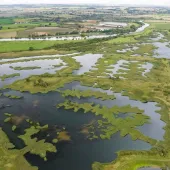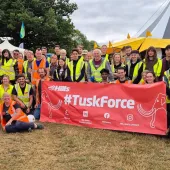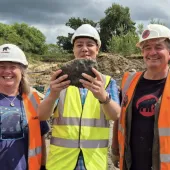Digging A Little Deeper

Hanson sites helping archaeologists to extend knowledge of the past
Archaeological discoveries are often made during mineral extraction and help to extend society’s knowledge of the past. Hanson UK work in accordance with the CBI protocol on archaeology and commission experts to undertake a survey before quarrying begins. A watching brief is also often adopted during extraction.
Hanson have developed a close working relationship with Oxford Archaeology, one of the largest independent archaeology and heritage practices in Europe. Together, they have uncovered several key finds that demonstrate the important role that quarrying companies have to play in preserving the nation’s archaeological heritage.
Cassington
Specialists and volunteers from Oxford Archaeology have been working at Hanson’s Cassington sand and gravel quarry in Oxfordshire since 1989, with the support of English Heritage. It is one of the biggest archaeological investigations ever carried out on a single site.
The final pieces of a huge archaeological jigsaw were completed last year with the excavation of a 3,000-year-old Bronze Age village in the quarry’s western extension.
The settlement was uncovered in the final stages of Oxford Archaeology’s research. It was previously thought that people in this area 3,000 years ago lived in small farmsteads surrounded by grassland on which they grazed small herds of cows and sheep.
The excavations revealed a small village inhabited by about six families for whom cereal cultivation seems to have been the major activity. The team also found all kinds of objects that would have been used on a day-to-day basis, such as tools for spinning and sewing, as well as metal objects that would have been acquired with agricultural surpluses.
Oxford Archaeology have excavated 24ha of land at the Hanson site over a 15-year period and discovered evidence of people living on the Yarnton and Cassington floodplain, near the river Thames, for 6,000 years. They uncovered the remains of one of the oldest houses ever found in England, as well as fragments of the animals the inhabitants ate and the bread they baked.
The site has made a huge contribution to understanding the earliest people to live and farm in the Upper Thames Valley.
Sutton Courtenay
Oxford Archaeology have recently published a 140-page report into an eight-year investigation at Hanson’s Sutton Courtenay sand and gravel quarry in Oxfordshire. The practice undertook evaluations of the quarry in 1993 and 1997, ahead of mineral extraction, and carried out a programme of more extensive work between 1997 and 2005, monitoring topsoil stripping and recording the archaeological remains exposed by this process.
The earliest feature examined was a Neolithic pit, but the main result of the fieldwork was to reveal extensive Bronze Age and early Roman-period landscapes. The Bronze Age features were concentrated in the western and central areas of the site and comprised rectilinear systems of trackways and field enclosures. Large pits or waterholes that were associated with these systems were probably related to stock control. A small group of cremation burials to the south may have been contemporary with these features.
There was no significant evidence for late Bronze Age or Iron Age activity but, at about the middle of the first century AD, a high-status double-ditched enclosure was established. This had an entrance to the south and contained slight traces of one or more timber structures.
The early Roman settlement ceased to be occupied after around 120AD and, although trackways and possibly some other boundaries remained in use, later Roman and subsequent activity was entirely agricultural in nature. This pattern of land use continued into modern times.
Horcott
Evidence of a Roman enclave – including the largest burial ground found in Gloucestershire – was uncovered by Oxford Archaeology during investigations on land earmarked for an extension at Hanson’s Horcott sand and gravel quarry near Fairford.
In addition to a Roman graveyard and farmstead, the archaeologists revealed a multi-phase settlement area with evidence of occupation from the early Iron Age, the Romano-British and the early-to-middle Saxon periods. The Saxon settlement, with as many as 40 sunken-featured buildings, overlies the early Iron Age settlement.
The significance of the site lies in its scale and complexity and also the discovery of a Romano-British stone building of a kind not previously excavated.
Hanson communications manager David Weeks said: ‘We have a long and successful relationship with Oxford Archaeology and are always happy to help with their investigations.
‘The discoveries made highlight the important part that responsible quarrying companies, such as Hanson, have to play in analysing, protecting and preserving our national heritage.’








